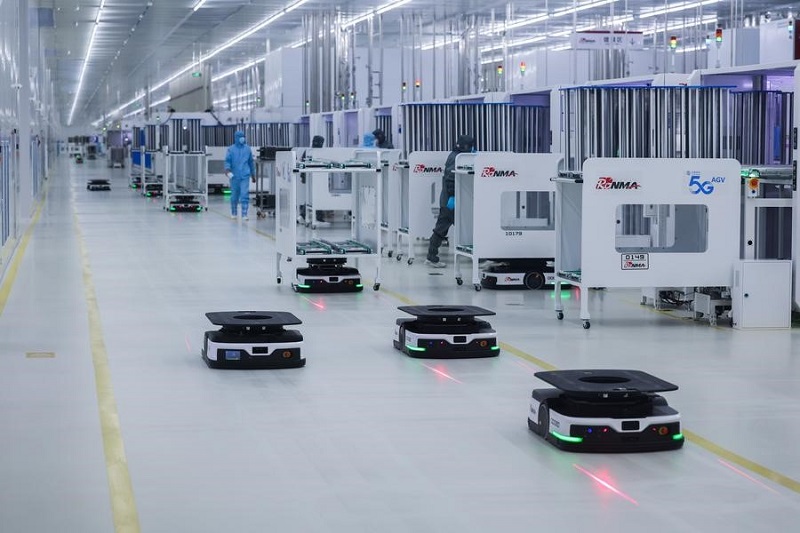In contrast to the countries which, in imposing unreasonable tariffs and enacting discriminatory bills, have wielded the cudgel of protectionism, China has vowed to ratchet up efforts to foster a globally competitive, open environment for scientific and technological innovation. Chinese President Xi Jinping laid emphasis on the efforts on June 11, while presiding over the fifth meeting of the Central Commission for Deepening Overall Reform.

Smart robots operate at a workshop of Ronma Solar in Jinhua City, east China's Zhejiang Province, Feb. 19, 2024. (Xinhua/Xu Yu)
In light of the country’s commitment to improve the system and mechanism of opening-up, Xi underlined the vital role played by the latter in the country’s science and technology sector, which is expected to proactively integrate the globally oriented innovation system into the global innovation network.
Professionals and talent in the sci-tech sector have been instrumental in the country’s innovation.
In a recent reply letter to Dean of College of AI under Tsinghua University Andrew Chi-Chih Yao, Xi expressed his hope that Yao would take the lead in exploring approaches to cultivating innovative talent, and fostering interdisciplinary integration and frontier innovation. Such efforts would contribute to the country’s drive to achieve greater self-reliance and strength in science and technology, Xi said.
Yao is among the many scholars that have returned to China over the past several decades after an extended stay in the West. Since 2012, Chinese overseas students have shown a growing tendency to return to their home country, according to the 2022 Blue Paper for Chinese Overseas Students Returning to China for Employment released by the Chinese Service Center for Scholarly Exchange. During the period 2012-2022, about 3.4 million Chinese, accounting for more than 80 percent of the country’s overseas students, came back.
“More than half of the Chinese students around me plan to return to China to work. We believe that our international thinking and vision can give us a more competitive edge in the job market,” said Zhao Zhijin, a student at Japan’s Musashi University, according to Xinhua.
Many returnees attribute their decision to China’s growing development opportunities, and the favorable conditions that have been created for them. In 2015, China issued a notice on facilitating the entrepreneurship of returned overseas students, closely followed by another notice in 2016 on offering entrepreneurship guarantee loans to support entrepreneurship and employment. China’s Ministry of Education data show that during the period 1978-2019, 4.23 million of 6.56 million Chinese studying abroad chose to return to China after finishing their studies.
President Xi has emphasized the vital role of scholars that have returned from abroad. In his congratulatory letter to the 110th founding anniversary in 2023 of the Western Returned Scholars Association, Xi expressed hope that overseas Chinese students and scholars would carry forward their patriotic tradition, serve the people, stay confident, break new ground and forge ahead, and maintain an open and inclusive mind to promote the exchanges and mutual learning between China and other countries.
The recent meeting also underlined the expansion of international scientific and technological exchanges, and the establishment of cooperative partnerships bringing mutual benefits. In acknowledging the imperative for deep involvement in global science and technology governance, the country will combine the strategies of “bringing in” and “going global” to create an open and globally-competitive environment for scientific and technological innovation.
China has advanced its opening-up and international cooperation in science and technology over the past several decades. The country has, according to the Ministry of Science and Technology, established sci-tech cooperation relations with more than 160 countries and regions, and signed 116 inter-governmental agreements on sci-tech cooperation. Meanwhile, the country has also set up a global scientific research fund specifically to support foreign scientists’ participation in its science and technology programs. China proposed, at the inaugural Belt and Road Conference on Science and Technology Exchange last November, the joint building of a global science and technology community that provides an open, fair, equitable and non-discriminatory environment for international cooperation in science and technology. By the end of June 2023, China had helped its BRI partners to build more than 20 agricultural technology demonstration centers, and to set up 50-plus BRI joint laboratories in such fields as agriculture, new energy, and health.
The 2023 edition of the Global Innovation Index (GII), released by the World Intellectual Property Organization (WIPO), shows that sci-tech clusters in China have increased to 24, compared with 21 last year, so placing the country at the top of the global list. In 2023, the country’s total expenditure on research and development reached RMB 3.3 trillion, a year-on-year increase of 8.1 percent.
This year, China’s government work report revealed an AI Plus initiative, aimed at fueling the country’s digital economy and spurring the smart transformation and modernization of manufacturing sectors. In fact, the past several years witnessed, with the launch of a series of smart manufacturing initiatives, China’s advance to the forefront of global innovation. The country now boasts 421 national-level showcase factories, according to Xinhua, encompassing a network of 10,000 or more provincial-level digital workshops and intelligent factories.